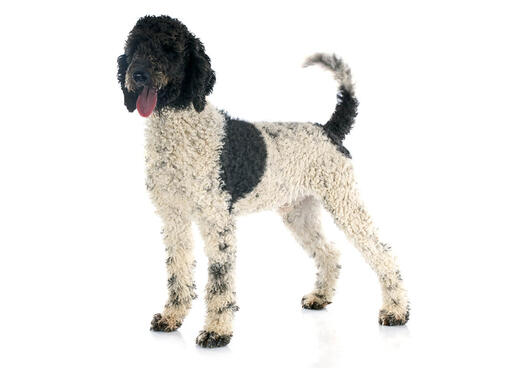
The courageous, lively Portuguese Water Dog was bred to assist fishermen at sea by retrieving, diving and guarding. The breed’s webbed feet, robust body and waterproof coat make him a superior swimmer. Obedient and affectionate, the energetic, athletic Portuguese Water Dog requires daily exercise. His thick, hypoallergenic coat sheds minimally, but regular grooming is recommended.
DID YOU KNOW? The Portuguese Water Dog originated in Portugal, where the breed is called the Cao de Agua, or “dog of water.” He also is commonly referred to as the Portuguese Fishing Dog.
ALSO KNOWN AS: Cão de Água Português
The need-to-know
- Dog suitable for experienced owners
- Some training required
- Enjoys vigorous walks
- Enjoys walking more than two hours a day
- Medium dog
- Minimum drool
- Requires grooming every other day
- Hypoallergenic breed
- Chatty and vocal dog
- Guard dog. Barks and alerts
- May require training to live with other pets
- Great family dog
Personality

Possibly as a by-product of a history of sitting quietly in boats before leaping into action, the Portuguese Water Dog, while extremely active, is surprisingly self-controlled and very trainable. They are friendly, happy dogs who bond closely to their families and who enjoy being a part of everything - but without training and enough exercise and stimulation they can become bored and unruly. Water is, unsurprisingly, a magnet for them!
History and Origins

Country of Origin: Portugal
An ancient breed, the Portuguese Water Dog is closely related to the other waterfowl retrieving dogs of Europe but it is not classed as a gundog as its skills were put to very different uses. Instead of being a retriever, the Portuguese Water Dog was very much a fisherman’s friend working alongside their owners on the southern coast of Portugal - and would herd fish, move nets, retrieve escaped fish and would even take messages from boat to boat. With their keen eyesight, they would alert fishermen to shoals of fish in the water and on foggy nights, they would even act as a canine foghorn, barking to alert other boats to their presence.
Nutrition and Feeding

Your dog's diet needs to have the right balance of all the main nutrient groups including a constant supply of fresh water. It's also important to conduct regular?body condition?scores to ensure you keep your dog in ideal shape and remember to feed them at least twice daily and in accordance with the feeding guidelines of their particular food.
Exercise

The Portuguese Water Dog needs at least an hour and a half’s daily exercise - to include free-running, exploration and sniffing - but preferably much more. They also need plenty of owner interactions in terms of games, interactive toys and training to keep their busy brains occupied. They are real water babies and so if owners can find a hydrotherapy pool or safe swimming opportunities, they will be in heaven!
Other Information

Health and common issues
As with many breeds, the Portuguese Water Dog can suffer from hereditary eye disorders and hip dysplasia (a condition that can lead to mobility problems). Eye testing and hip scoring of dogs prior to breeding is therefore important. They should also be DNA tested for a rare but serious inherited heart condition that can occur in the breed. The breed club monitor the health of the breed carefully and should be contacted for the most up-to-date information and details of any DNA or additional testing they recommend. Breed Clubs can be found on the Kennel Club website.
Space requirements
While not large dogs, the Portuguese Water Dog does need a lot of exercise, and so need a more rural home or daily access to a variety of open spaces. They appreciate a large garden which will need to be well fenced.
Training portuguese water dogs
The Portuguese Water Dog is a smart, intelligent breed who is quick to learn and can easily become the star of any training class - however like many clever dogs, owners need to find ways to motivate them using reward-based methods and by keeping training enjoyable as they have an independent streak and a low boredom threshold that can lead them to going ‘self-employed’ (especially near water!).
Best family dog breeds
With their friendly, self-controlled, gentle nature, the Portuguese Water Dog makes an ideal companion for an active family - and will happily get on with other animals if introduced to them at an early age. While many dogs are traditionally thought of as being good with children, all dogs and children need to be taught to get on with and respect each other, and be safe together. Even so, dogs and young children should never be left alone together and adults should supervise all interactions between them.
Did you know?
- The last canine residents of the White House were Portuguese Water Dogs. Bo was given to President Obama as a gift from Senator Ted Kennedy, and during his time in Washington he was known as the ‘first dog’. The Obamas were so enchanted by Bo that they got Sunny, another Portuguese Water Dog, as a playmate for him.
- Portuguese Water Dogs have webbed feet which makes them amazing swimmers.
- Despite being very fluffy, they have no undercoat which means they don’t really shed.
- The first account of a Portuguese Water Dog was in 1297 when a monk reported a dying sailor who had been rescued from the sea with a dog with a ‘black coat of rough hair, cut to the first rib and with a tuft on the tip of his tail’.
- It’s thought that their bloodline influenced other breeds such as the Irish Water Spaniel and the Kerry Blue Terrier.